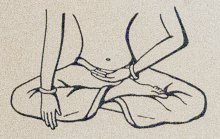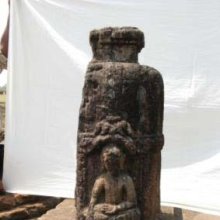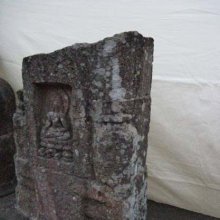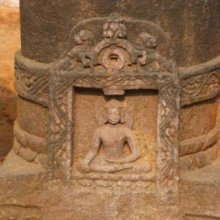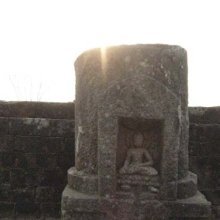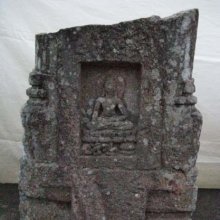Bhumisparshamudra, Bhumisparsha-mudra, Bhūmisparśamudrā, Bhumisparsha-mudda: 1 definition
Introduction:
Bhumisparshamudra means something in Buddhism, Pali. If you want to know the exact meaning, history, etymology or English translation of this term then check out the descriptions on this page. Add your comment or reference to a book if you want to contribute to this summary article.
The Sanskrit term Bhūmisparśamudrā can be transliterated into English as Bhumisparsamudra or Bhumisparshamudra, using the IAST transliteration scheme (?).
Images (photo gallery)
(+20 more images available)
In Buddhism
General definition (in Buddhism)
Source: Exotic India: Mudras of the Great BuddhaLiterally Bhumisparsha translates into 'touching the earth'. It is more commonly known as the 'earth witness' mudra. This mudra, formed with all five fingers of the right hand extended to touch the ground, symbolizes the Buddha's enlightenment under the bodhi tree, when he summoned the earth goddess, Sthavara, to bear witness to his attainment of enlightenment. The right hand, placed upon the right knee in earth-pressing mudra, and complemented by the left hand-which is held flat in the lap in the dhyana mudra of meditation, symbolizes the union of method and wisdom, samasara and nirvana, and also the realizations of the conventional and ultimate truths. It is in this posture that Shakyamuni overcame the obstructions of Mara while meditating on Truth.
The second Dhyani Buddha Akshobhya is depicted in this mudra. He is believed to transform the delusion of anger into mirror-like wisdom. It is this metamorphosis that the Bhumisparsha mudra helps in bringing about.
See also (Relevant definitions)
Partial matches: Bhumisparsha, Mudda, Mudra.
Full-text (+8): Bhumisparsha, Gautama, Mahidhara, Sikhin, Vipashyin, Shikhi, Vishvabhu, Shikhimalini, Kanthamalini, Krakucchanda, Vipasyanti, Akashaganja, Kanakaraja, Kashyapa, Kanakamuni, Yashodhara, Visvadhara, Vipashyi, Kakudvati, Dharmadhara.
Relevant text
Search found 9 books and stories containing Bhumisparshamudra, Bhumisparsha-mudra, Bhūmisparśamudrā, Bhumisparsha-mudda, Bhumisparshamudda, Bhūmisparśa-mudrā, Bhumisparsamudra, Bhumisparsa-mudra; (plurals include: Bhumisparshamudras, mudras, Bhūmisparśamudrās, muddas, Bhumisparshamuddas, mudrās, Bhumisparsamudras). You can also click to the full overview containing English textual excerpts. Below are direct links for the most relevant articles:
Stupas in Orissa (Study) (by Meenakshi Chauley)
Minor Structural Stupas at Ratnagiri < [Chapter 4]
Minor Votive Stupas at Ratnagiri < [Chapter 4]
Buddha Images < [Chapter 5]
Sripura (Archaeological Survey) (by Bikash Chandra Pradhan)
Stone Images (1): Buddhist Images < [Chapter 3 - Sculptural Programme]
Svastik Vihara < [Chapter 2 - The Architectural Panorama]
Ananda-Prabha-Kuti-Vihara < [Chapter 2 - The Architectural Panorama]
Vietnamese Buddhist Art (by Nguyen Ngoc Vinh)
4. Thailand Sculptures (d): Khmer Period < [Chapter 4 - The Sculpture and its Reciprocal Influence]
7. Buddhist monuments in Indonesia and Borobudur < [Chapter 2 - Similarity of Buddhist monuments in South Vietnam and South East Asia]
Amaravati Art in the Context of Andhra Archaeology (by Sreyashi Ray chowdhuri)
The defeat of Māra < [Chapter 3 - Amarāvatī and the Formative Stage of the Buddhist Art]
Jainism in Odisha (Orissa) (by Ashis Ranjan Sahoo)
Santinatha image at Amrutesvara Temple, Tala Beguniapada < [Chapter 3: Survey of Jaina Antiquities in Odisha]
The gods of northern Buddhism (by Alice Getty)
